When you're looking to manage your finances effectively, popular budgeting apps like YNAB, Mint, and PocketGuard can help. YNAB offers a zero-based budgeting approach and boasts high user ratings, while PocketGuard shows you how much you can spend after bills. Goodbudget takes a traditional envelope method but requires manual entry. Each app varies in cost, features, and user experiences, providing a range of options for different needs. Understanding their key features and user feedback can guide your decision. Keep exploring to uncover which app suits your budgeting style best!
Key Takeaways
- YNAB offers a zero-based budgeting approach and is highly rated at 4.8 on both app stores, but requires a subscription after a free trial.
- Goodbudget utilizes a traditional envelope method with manual entry, rated 4.6, and offers a free version alongside a premium option.
- PocketGuard displays spendable cash after bills, offering both free (rated 4.6) and premium versions, known for its user-friendly interface.
- Empower Personal Wealth and Honeydue are completely free options, with Empower rated 4.8 and Honeydue receiving mixed feedback (4.5 on Apple, 3.8 on Google).
- Security features like data encryption and two-factor authentication are critical in safeguarding user financial information across all apps.
Overview of Budgeting Apps
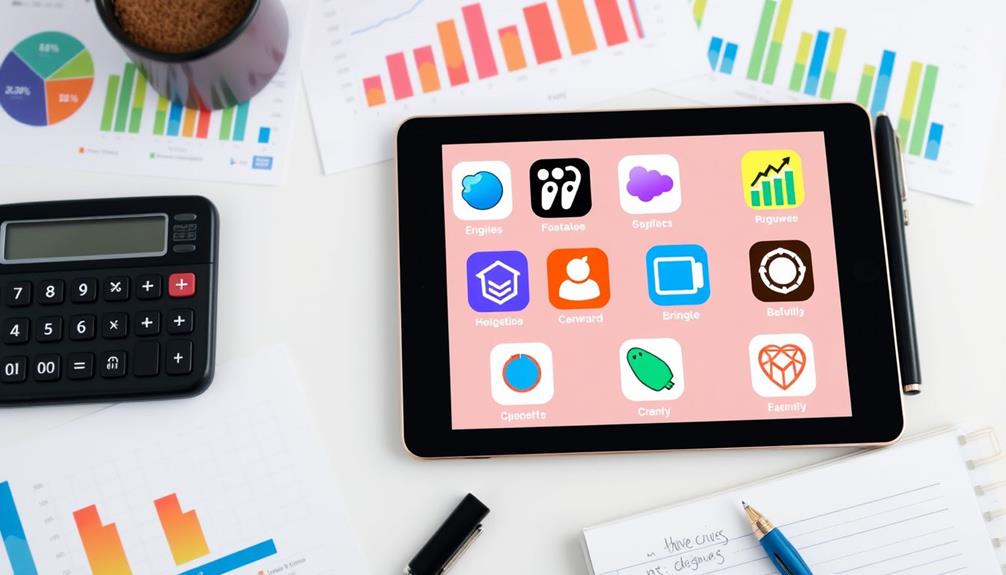
Budgeting apps are essential tools for anyone looking to take control of their finances. They help you track your income and expenses, allowing you to create a personalized spending plan that works for you. Many popular budgeting apps, like YNAB, Mint, and PocketGuard, offer a free version, making it easy to get started without any upfront costs.
Additionally, it's important to set clear, specific objectives in your budgeting process to avoid common goal tracking pitfalls, ensuring that your financial goals are well-defined and achievable.
One of the standout features of these apps is automatic transaction categorization, which simplifies the process of managing your finances. You can easily see where your money's going, helping you make informed decisions. YNAB, for example, promotes a proactive zero-based budgeting approach, encouraging you to allocate every dollar you earn.
Most budgeting apps also support multi-device synchronization, so you can access your financial information anytime, whether you're on your smartphone, tablet, or desktop. Additionally, they provide detailed financial reports to help you monitor your progress.
Security features are vital, too. With data encryption and two-factor authentication, your personal finance information remains safe and secure.
Key Features of Each App
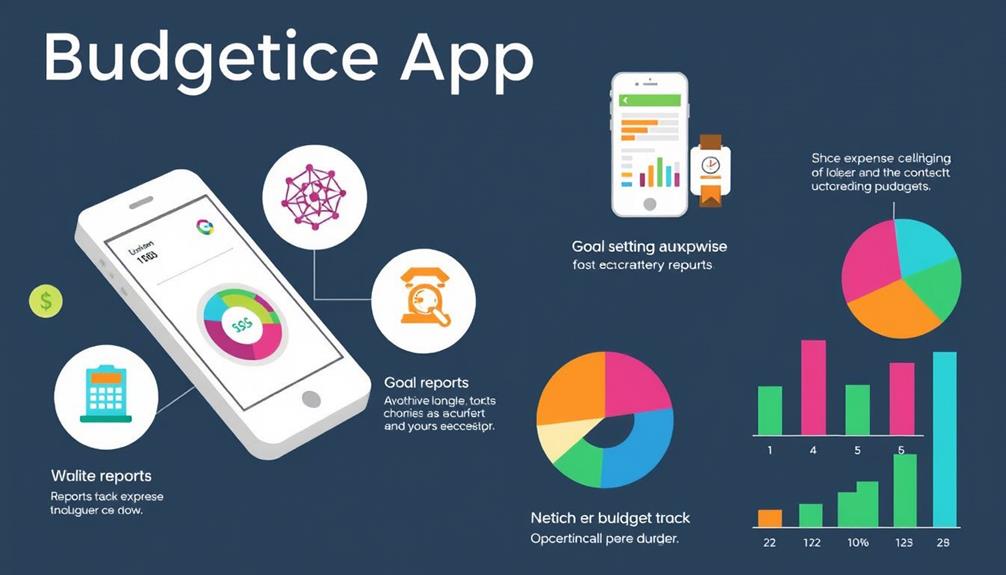
When choosing a budgeting app, understanding the key features of each option can greatly influence your financial management experience.
YNAB focuses on proactive financial planning through a zero-based budgeting approach, requiring you to allocate every dollar as soon as you receive it. It also offers extensive educational resources to improve your budgeting habits, which can be beneficial if you're looking to protect your savings through better financial practices.
Goodbudget uses the traditional envelope method, which requires manual entry of expenses and balances. You can create digital envelopes for various budget categories, but it doesn't sync with your bank accounts.
EveryDollar offers a straightforward zero-based budgeting framework. The free version requires manual entry of transactions, while the premium version allows account syncing and additional features for a fee.
PocketGuard simplifies budgeting by showing you how much spendable cash you have left after considering bills and necessities. It also has both a free version and a premium version with advanced features.
Lastly, Honeydue is designed for couples, enabling you to link bank accounts, categorize joint expenses, and set monthly limits while facilitating communication about shared finances.
Each app presents unique features catering to different budgeting needs.
User Experience and Feedback

User experiences with budgeting apps can vary greatly, affecting how effectively you manage your finances. For instance, user ratings reveal that YNAB and Empower Personal Wealth boast impressive averages of 4.8 on the Apple Store, showcasing strong user satisfaction. In contrast, Honeydue has mixed feedback, scoring 4.5 on Apple but only 3.8 on Google Play, highlighting differing user experiences across platforms.
Additionally, many users appreciate the opportunity to earn money online through various avenues, such as freelancing, which can complement their budgeting efforts.
Many users praise the intuitive interface of apps like PocketGuard and YNAB, which makes budgeting easier and encourages regular engagement. However, the learning curve can differ considerably. While some users appreciate YNAB's detailed control and manual categorization, others may find it overwhelming and prefer simpler, automated tools like PocketGuard.
Customer support also plays an essential role in user experience. YNAB stands out for its extensive educational resources, which help users adapt to its proactive budgeting features. This quality support can be a game-changer, especially if you're maneuvering through the complexities of budgeting apps.
Ultimately, your choice of app may hinge on the balance between desired features, usability, and the kind of support you need to guarantee a positive user experience.
Cost Comparisons and Options
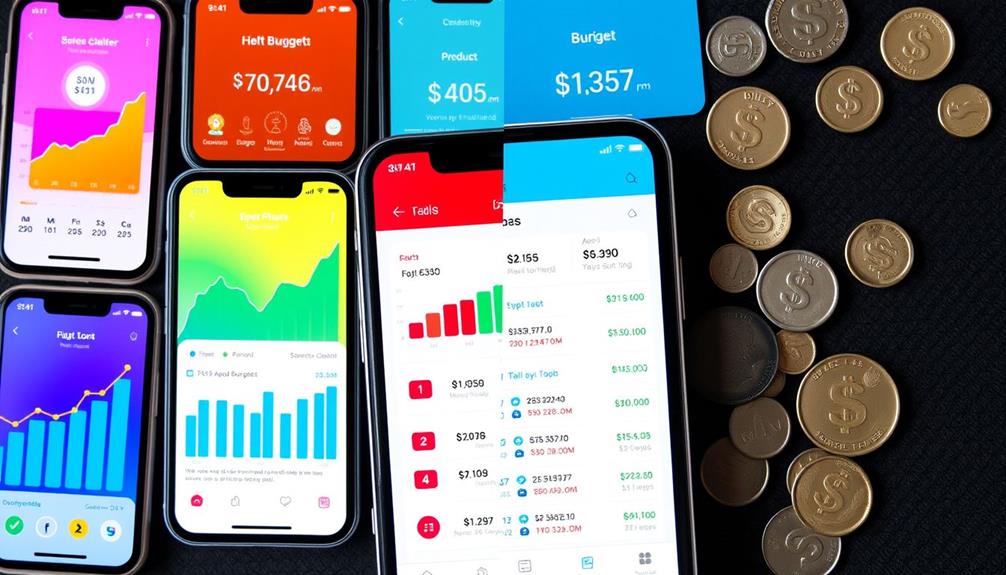
Maneuvering the cost landscape of budgeting apps can feel overwhelming, but understanding your options is key to finding the right fit for your financial needs.
Consider the benefits of diversification in your financial planning, similar to how one might approach Gold IRA Rollovers for retirement investments.
YNAB (You Need A Budget) charges $14.99 per month or $109 annually, offering a 34-day free trial for newcomers. If you're looking for a free version, Goodbudget provides limited features, while its premium version costs $10 per month or $80 per year.
PocketGuard has a basic free version, but you can upgrade to the premium version for $12.99 monthly or $74.99 annually.
EveryDollar also offers a free version that requires manual transaction entry, with its premium version available for $79.99 per year.
For those seeking completely free budgeting tools, Empower Personal Wealth and Honeydue stand out, giving you robust financial management without any subscription fees.
When doing your cost comparisons, consider what features matter most to you—whether that's envelope budgeting with Goodbudget or automated tracking with YNAB.
Each app presents unique pricing structures, so weigh your options to find the best budgeting solution for your lifestyle.
Security and Privacy Measures

Ensuring your financial data stays secure is vital when using budgeting apps. You want to protect your sensitive data, especially since these apps often link to your bank accounts. Additionally, implementing robust security measures can greatly enhance your overall experience, as these practices also contribute to increased user engagement.
Here are some key security and privacy measures to take into account:
- Data Encryption: Most budgeting apps use data encryption to safeguard your financial information during transmission and storage. This means your data is scrambled, making it difficult for unauthorized users to access.
- Two-Factor Authentication (2FA): Many apps implement 2FA as an extra security layer. You'll need to verify your identity through a secondary method, like a text message or an authentication app, adding an additional hurdle for potential intruders.
- User Control: Look for apps that give you control over your personal data. You should be able to manage privacy settings and decide what information is shared with the app and third parties.
- Privacy Policies: Always review the privacy policies of budgeting apps. Understanding their data sharing practices is essential, as some may share your information for marketing or analytical purposes.
Effectiveness and User Ratings
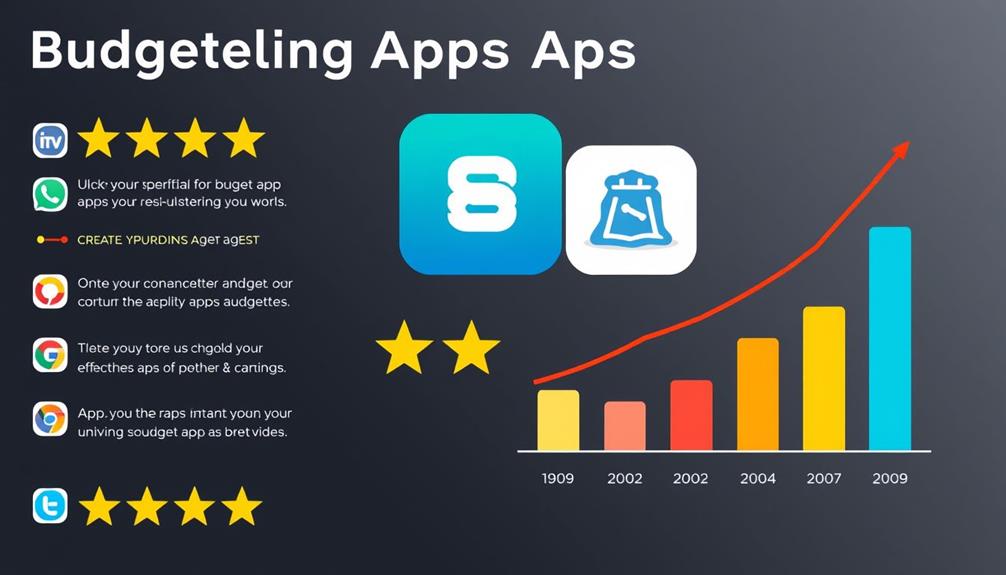
When it comes to choosing a budgeting app, effectiveness and user ratings play a crucial role in your decision-making process. Here's a quick overview of how some popular apps stack up based on user feedback:
| App Name | User Ratings (Apple/Google) | Key Features |
|---|---|---|
| YNAB | 4.8 | Effective financial management |
| Empower Personal Wealth | 4.8 | Strong budgeting features |
| Goodbudget | 4.6 | Envelope budgeting, manual entry |
| PocketGuard | 4.6 / 4.1 | User-friendly interface for budgeting |
| Honeydue | 4.5 / 3.8 | Couples' shared finance management |
| EveryDollar | Varies | Free manual entry; premium features |
YNAB and Empower Personal Wealth both boast impressive user ratings of 4.8, indicating strong satisfaction. Goodbudget, with a 4.6 rating, is praised for its envelope budgeting method despite the manual entry requirement. PocketGuard stands out with a 4.6 rating on Apple and 4.1 on Google Play for its user-friendly approach. Honeydue's 4.5 rating on Apple shows promise for couples, but its 3.8 on Google suggests some improvement is needed. Finally, EveryDollar's effectiveness varies, reflected in its mixed usability reviews.
Additional Resources for Budgeting

When it comes to budgeting, you've got plenty of free resources at your fingertips. From tools that help you track your spending to detailed guides on various budgeting methods, there's something for everyone.
Additionally, participating in online workshops and webinars can enhance your financial literacy, providing insights into effective budgeting strategies and tools that align with your goals.
For example, hackathon trends often highlight innovative budgeting solutions developed by tech enthusiasts.
Let's explore some of the best budgeting tools and educational content available online to enhance your financial skills.
Free Budgeting Resources Available
Frequently, people seek out free budgeting resources to help manage their finances effectively, and there are plenty of options available. Utilizing these tools can make it easier to track spending and maintain control over your financial accounts.
Additionally, adopting a balanced approach to budgeting can enhance your financial health, similar to how setting realistic weight loss goals can maintain motivation during weight loss journeys.
Here are some valuable free budgeting resources to evaluate:
- NerdWallet Budgeting Resources: This app helps you track cash flow and spending against the 50/30/20 budget guidelines, along with offering budget planners and online spreadsheets.
- Goodbudget: Its free version provides an envelope budgeting system that allows manual entry of expenses, helping you track finances without needing bank syncing.
- EveryDollar: The free version of EveryDollar is perfect for those who prefer simplicity, as it focuses on manual entry of income and expenses.
- Empower Personal Wealth: Formerly known as Personal Capital, this free tool helps you monitor your overall wealth while tracking spending habits across multiple financial accounts.
Additionally, many apps offer community support and resources for financial education, enhancing your budgeting experience.
Using these free budgeting apps can greatly aid your journey toward financial stability.
Budgeting Tools Comparison Guide
To effectively choose the right budgeting app, it's helpful to compare the features and functionalities of popular tools like YNAB, Mint, and PocketGuard. Each budgeting app has unique strengths that can cater to different aspects of your financial management.
For instance, YNAB emphasizes proactive budgeting, while Mint offers a more thorough overview of your spending categories and cash flow. Additionally, understanding the importance of verifying personal information through detailed processes can enhance your overall financial decisions, as highlighted in background checks.
Many apps provide free versions, allowing you to test their basic features before committing to premium features. This way, you can weigh the cost versus benefits effectively.
When making your app comparison, pay attention to user ratings. Top-rated apps like YNAB and Empower Personal Wealth often receive high scores for effectiveness and usability, so these ratings can guide your decision.
Additionally, consider the security features of each app. Look for data encryption, two-factor authentication, and clear privacy policies to guarantee your personal finances are protected.
Supplementing your app choice with resources like NerdWallet can also enhance your budgeting journey by offering insights on cash flow management and strategies for achieving your financial goals.
Educational Financial Content Online
While traversing the world of budgeting, you'll find that educational financial content online can greatly enhance your understanding and skills. Leveraging these resources can markedly improve your financial literacy and help you set realistic savings goals.
By incorporating principles from a healthy lifestyle into your financial habits, you can create a more sustainable approach to budgeting. Here are some key educational resources to reflect upon:
- Articles and Videos: Many budgeting apps like YNAB and NerdWallet offer extensive articles and videos that cover various budgeting strategies, including the popular 50/30/20 rule.
- Community Forums: Engaging in community forums allows you to share experiences and gain insights from others practicing effective budgeting.
- Built-in Tutorials: Apps such as YNAB feature built-in tutorials and workshops, making it easier to grasp budgeting principles and techniques.
- Tools for Financial Management: Online platforms often provide tools for calculating budgets and establishing emergency funds, emphasizing the importance of proactive financial management.
Methodology for App Selection
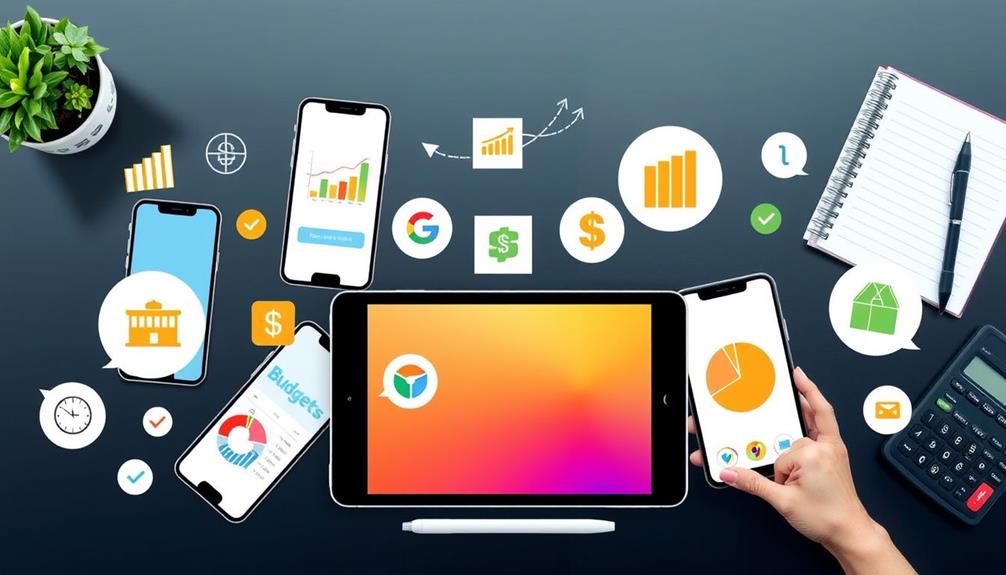
When choosing the best budgeting apps, you need to contemplate a few key evaluation criteria.
You'll want to look at user experience, focusing on how easy the apps are to navigate and their overall design.
Additionally, examining user privacy concerns and how the apps manage data can be essential in making an informed decision.
Evaluation Criteria Overview
An effective evaluation of budgeting apps hinges on several key criteria that determine their overall utility for personal finance management. By focusing on these factors, you can identify which apps best meet your needs.
- Expense Tracking: The app should offer thorough tools for tracking your expenses, including bill reminders and goal-setting features.
- User Experience: A seamless user experience is fundamental. This includes an intuitive interface, ease of navigation, and overall usability that keeps you engaged.
- Security and Privacy: Investigate the app's security measures, such as data encryption and two-factor authentication. Understanding privacy policies regarding user data sharing is crucial to protect your information.
- Cost Analysis: Compare the cost of free versions versus subscription plans. Determine if the premium features justify the expense and fit within your budget.
Additionally, user feedback plays a key role in evaluating reliability. Aim for apps that maintain a minimum rating of 4.5 stars on iOS or 3 stars on Google Play, with at least 1,000 reviews.
This helps guarantee you're choosing a budgeting app that others find valuable for their financial management.
User Experience Assessment
To uncover the best budgeting apps, we focused on evaluating user experience through a straightforward methodology designed to highlight ease of use and accessibility.
Our assessment prioritized user-friendly designs, guaranteeing that individuals with varying financial backgrounds could navigate effortlessly.
We gathered reviews from certified financial planners and users, requiring a minimum rating of 4.5 stars on iOS or 3 stars on Google Play, with at least 1,000 reviews for inclusion.
Key criteria included account connectivity, auto-categorization features, and budget suggestions.
We also examined visual aids for spending analysis and available support services to enhance overall financial management.
The evaluation process emphasized long-term usability and design aesthetics, which are essential for keeping users engaged with their financial goals.
By incorporating insights from financial planners, we guaranteed that the selected apps align with effective budgeting theories and practical strategies.
Ultimately, our user experience assessment not only identifies the best budgeting apps but also helps you choose tools that make managing your finances more intuitive and effective, paving the way for improved financial health.
Frequently Asked Questions
What Is the #1 Budgeting App?
If you're looking for the #1 budgeting app, consider YNAB. It helps you allocate every dollar, promotes financial responsibility, and integrates with your accounts, offering a user-friendly experience that keeps your budgeting on track.
Which of the Following Is the Best Tool for Budgeting?
When choosing the best budgeting tool, consider your unique needs. YNAB's hands-on approach suits those wanting control, while PocketGuard simplifies tracking. Evaluate features and costs to find what fits your lifestyle best.
How to Choose the Best Budgeting App?
To choose the best budgeting app, identify your preferred budgeting style, evaluate essential features, consider costs or free trials, check user ratings, and review security measures to protect your financial information effectively.
Are There Better Budgeting Apps Than Mint?
Yes, there're better budgeting apps than Mint. You'll find YNAB's proactive approach, PocketGuard's spending simplicity, and Goodbudget's envelope method effective for your needs, each offering unique features that cater to diverse budgeting styles.
Conclusion
In the world of budgeting apps, you've got plenty of fish to choose from. Each tool offers unique features, so it's all about finding the right fit for your financial goals. By considering user feedback, costs, and security measures, you can make an informed choice that'll help you stay on top of your finances. Don't hesitate to explore these options—after all, managing your money effectively can set you on the path to financial freedom!










